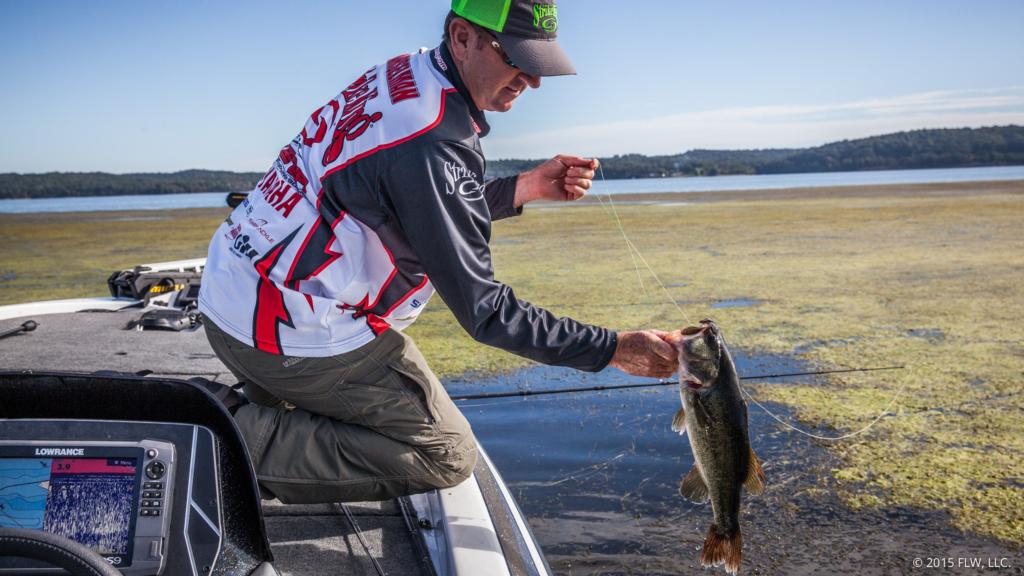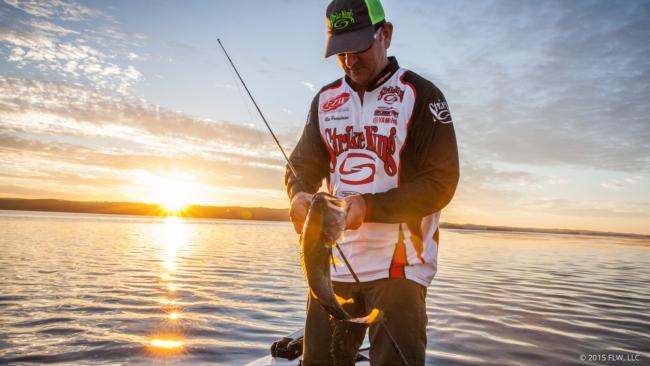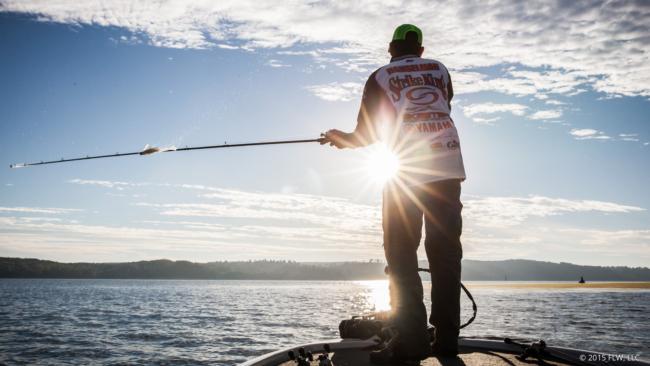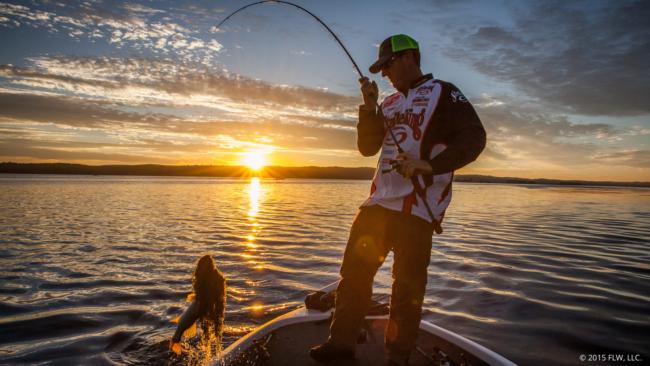10 Tips for Finding Bass in the Grass
Texas pro Ray “Hanselmania” Hanselman dissects a grass bed

Bass are bass, and grass is grass – at least to some extent.
For Texas pro Ray Hanselman, a full-time guide and tournament pro from the deep, clear and rocky waters of Lake Amistad along the Mexico border, grass fishing is a means to pay the bills, whether he’s cranking grass drains or punching through canopies of mature grass to reach the “caverns” within.
But put him on Kentucky Lake, a shallow current-driven reservoir of the Tennessee River, and surely the differences in habitat would give him some fits, right?
Apparently, not so much. I tagged along with “Hanselmania” – he earned the nickname this season during his three-tournament sweep of the Rayovac FLW Series Texas Division – the other day at a media event for a quick lesson in how to break down large expanses of grass in Kentucky Lake’s southern range near Paris, Tenn. He proved that the techniques that work on one grass lake often perform just as well on another.
Here’s what he showed me.
1. Dial in on hard edges
The first place we pull up to is a grass mat situated on a long, narrow ridge that runs parallel to the main river channel. The bankside edge of the grass mat is thick and straight and very “solid” without a lot of jagged grass on its fringe.
The grass grows like this because the bottom drops off suddenly to that side. While some folks don’t like fishing such straight grass edges, Hanselman wants to take a look. He says that an edge like this is a high-percentage place that congregates bass and can be easier to fish than a wider expanse of scattered grass.
“It creates more of a tighter edge where they’ll set up,” he explains. “It puts the odds a little more in your favor.”
2. Find access points
Our next stop is a very obvious grass mat growing on a shallow bar that connects to a small chain of mid-river islands. It’s a community grass mat apparently, as several other anglers are working the opposite side.
Hanselman pulls directly up to a section of grass with, again, a distinct edge. But it’s not the grass itself that so interests him. It’s what he sees on the map: a tight clustering of contour lines that show shallow bottom dropping off into deeper water.
“That’s a pretty good access point,” he says.
At this particular time, Kentucky Lake’s bass are somewhat in an in-between stage of their autumn migration from the depths to the shallows. They’re “unsure” where they want to be, which is caused partially by up-and-down air temperatures and also by reservoir managers beginning to drop the water level for fall and winter. This access point is where they can move back and forth between deeper water with current and shallow hunting habitat in the grass.
He gets a couple of lookers with a Strike King Sexy Dawg walking topwater, but the bites are weak and he never hooks up.
3. Bomb casts
Before we get too far, I pick up a few of Hanselman’s rods and inspect his weaponry. In typical Texas fashion, he’s fishing with braided line on all but his flipping setup, which is spooled with fluorocarbon, and he has five 7-foot, 11-inch Power Tackle No Rats rods on the deck.
“It’s a little overkill [the rod length],” he says, “but yet it’s not. I like to make long casts in shallow water, especially in places that get a lot of pressure. When the bait is way out there you can still get the hook set and get them in [with the long rod].”
To prove his point, he catches a skinny keeper – one of those giant-headed fish that should’ve weighed 4 pounds – at the end of a long cast with the Sexy Dawg and horses it back with about 5 pounds of grass attached.
4. Know when to stay and when to leave
When he’s in search mode, as he is on Kentucky Lake on this trip, Hanselman heads straight to the highest-percentage spots within the grass.
“If you don’t catch any off the first few really good-looking spots, consider moving,” he says.
What’s a “good-looking spot,” according to Hanselman? Points, cuts, hard edges, areas with visible bait. He also loves to target grass on the lee side of a point, which typically grows taller in its protected area, and “bridges” of grass across the back of drains. The drains are like ditches, or slightly deeper areas where the grass in the bottom is shorter than the grass along the sides. In the very back, the taller side grass grows across the drain and creates a bridge – aka: money spot.
Funny thing about bass, though, is that they’re never predictable. We fish two obvious points in the grass without any luck, and I suspect that Hanselman is about to call it when a brute of a bass blows up on the edge of the mat. We fire a frog and a worm at the spot, but we can’t draw another strike. About 50 yards farther down the edge, another fish swipes at the frog but misses the hooks, then another blasts through the surface. Though we don’t catch any, we do find a few. Hanselman figures that in a tournament he could probably stay and slow-fish a weightless worm or soft jerkbait for a keeper. We decide instead to keep moving, having learned another important lesson: Patience pays off.
5. Listen up
As we continue working closer to the islands, the grass gradually thickens within the mat, and the sound of “popping” bluegills gets more obvious. It’s a clue to throw a little farther into the mat, so Hanselman hands me the frog.
“With as much stuff as you can hear up there, they have no reason to be out here on the edge,” he says. “It sounds like they can make a living up there.”
A few casts later, a bass makes a half-hearted attempt at eating my frog through the mat but fails and just bounces it across the surface. I feel like we’re getting closer to figuring out these fish.
6. Observe the sun and wind
We continue hopping from spot to spot, and Hanselman inspects some looser grass on the upcurrent side of a mat along the secondary channel. As we round the corner and start working downstream, I throw the Sexy Dawg for a bit, but after grabbing grass a couple times I hang it on the reel and reach for the frog rod. Hanselman stops me.
“Keep throwing that thing,” he says. “I like a loud topwater in the wind.”
There isn’t much wind, but I realize that the micro-chop on the lake is blowing into this side of the bed. The grass is scattered, too, so the walking topwater is the better choice for covering water.
Hanselman is swimming a Strike King Hack Attack Swim jig with a small swimbait trailer. His technique is simple: Hold the rod high, reel with a medium retrieve and use short pops of the rod tip to pull it free of the grass. He gets a couple bites, but again, they don’t hook up. Hanselman says these fish just don’t know what they want.
7. Find ambush points in scattered grass
Hanselman decides to leave the channel and head for a small main-lake point with just enough water on it that bass can set up shop in the grass.
This grass is a little different, though. There’s a hard edge on the surface mat, paralleled by a thin band of open water then another “layer” of scattered clumps in a rough line.
“This looks perfect, where it’s broken up like this,” he says. “It’s an edge, but it’s scattered, so it has lots of ambush points.”
We don’t get any bites, but it makes me think a little harder about what a “good” edge looks like. The clumps are concentrated, so they can be fished quickly with a Texas-rigged worm and a frog, but they’re not in such a straight line that bass could be just anywhere. Each clump is a high-confidence target.
There’s also another lesson here …
8. Pick manageable spots
“When I feel like there are not a lot of fish in the grass, like right now, the odds are better on something like this spot, rather than where there are acres of grass,” Hanselman adds. “If all the fish are doing the same thing then it doesn’t matter so much where you fish. Grass is grass.”
9. Try and try again
We run down the lake to the end of another long shallow bar. On this spot, two “fingers” of grass extend out the downcurrent side, forming a U-shaped hollow in the middle.
Jumbo shad are flipping around, and we see several quality bass bust on the surface along the edge. Bluegills are popping everywhere. This mat has life.
Unfortunately, these are frustrating fish. They swipe at frogs and at Hanselman’s Texas-rigged worm but never get the hooks. We work through twice, first with the worm and surface baits and then with a slow-fished punch rig. Both approaches get the proverbial nibble, but neither produces a fish.
Unfortunately, we only have a few hours on this trip, so it’s time to leave. Hanselman has a clue. He knows the fish are there and feeding, and that they’re willing to look at both surface baits and punch baits. He just doesn’t have enough time to really dial in. What he’d like to do is re-fish the spot until he could find a bait, presentation or key area that produces.
10. Revisit key spots
A few hours later, I catch up with Hanselman again. He had another outdoor writer to take fishing, and they went back to that U-shaped spot to try again.
“We found them,” he says. “They were up in the mat.”
Whether it was the sunshine of midday that pushed those fish deeper into the grass or the fishing pressure, the key to unlocking the puzzle was to lob the frog deeper into the mat.
He reports catching a handful of keepers off that one little area. He had a clue and used it to expand his investigation. It paid off.


